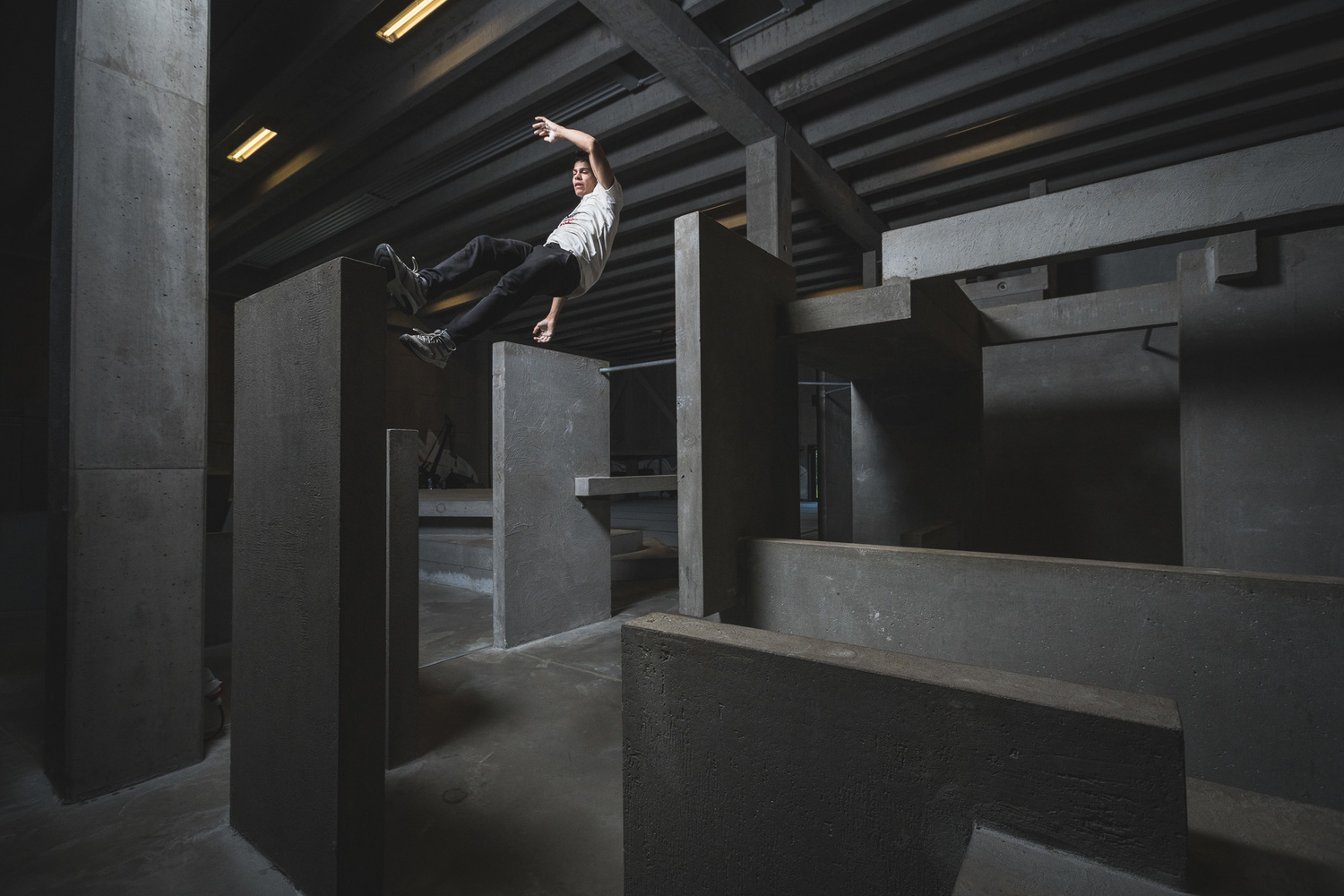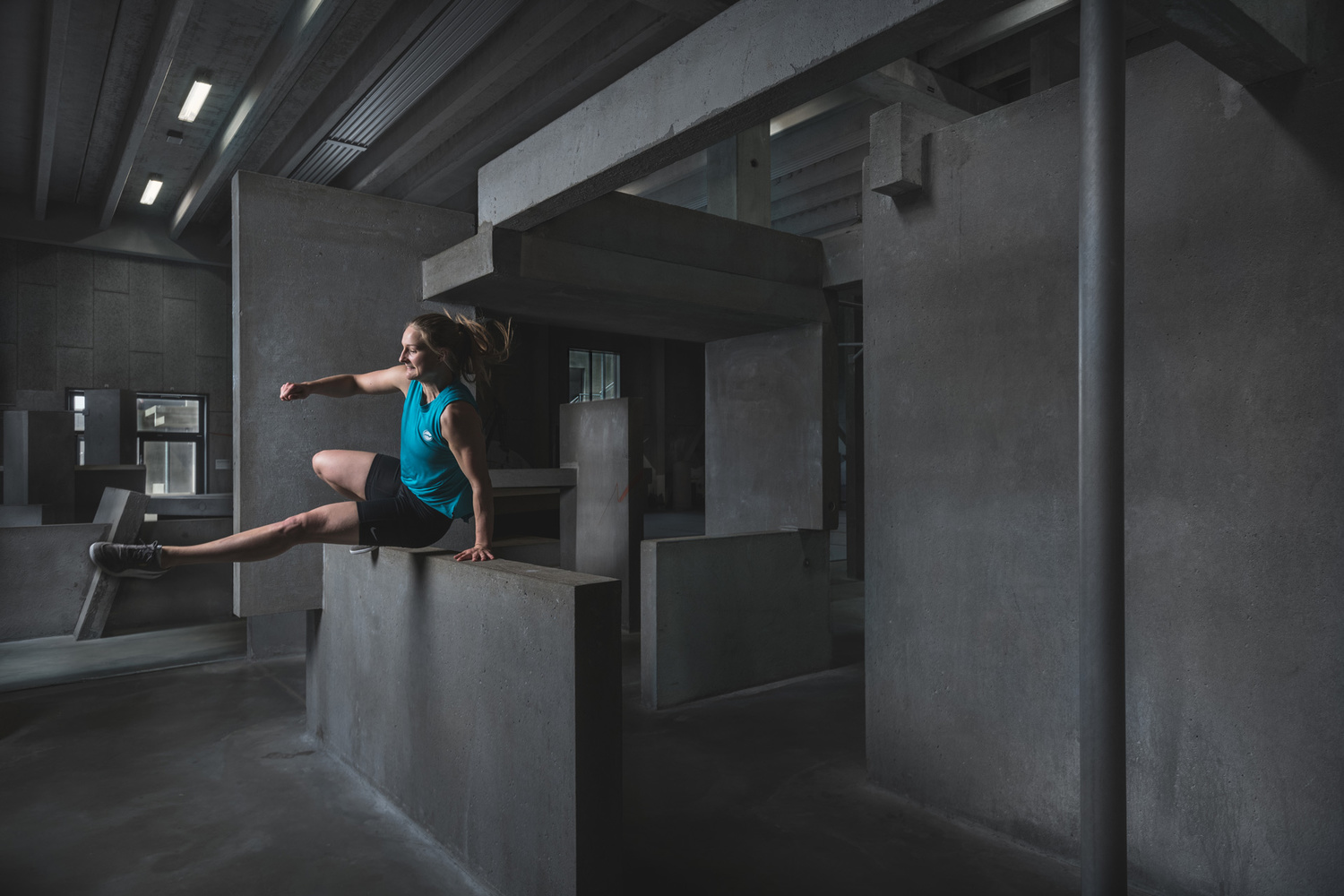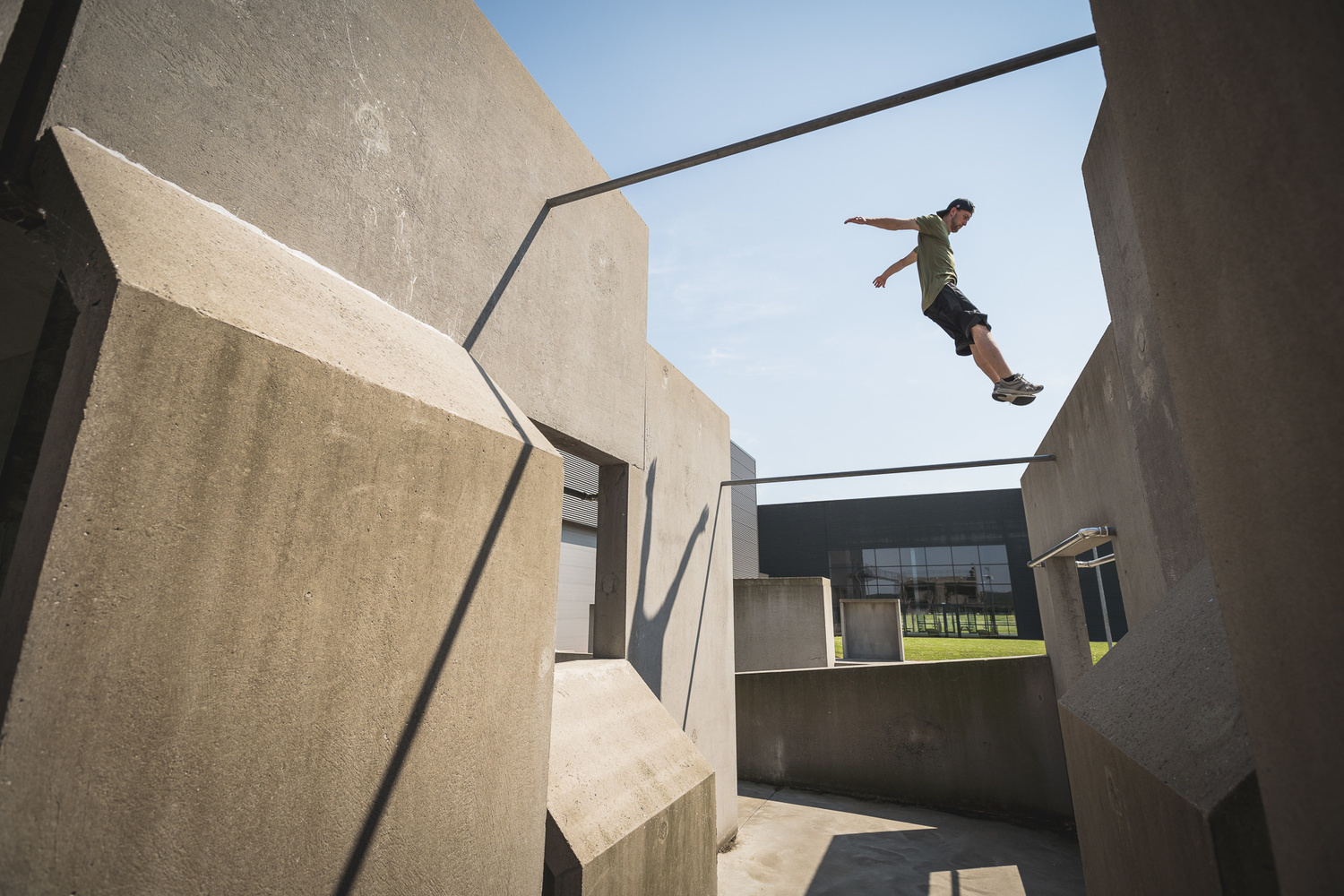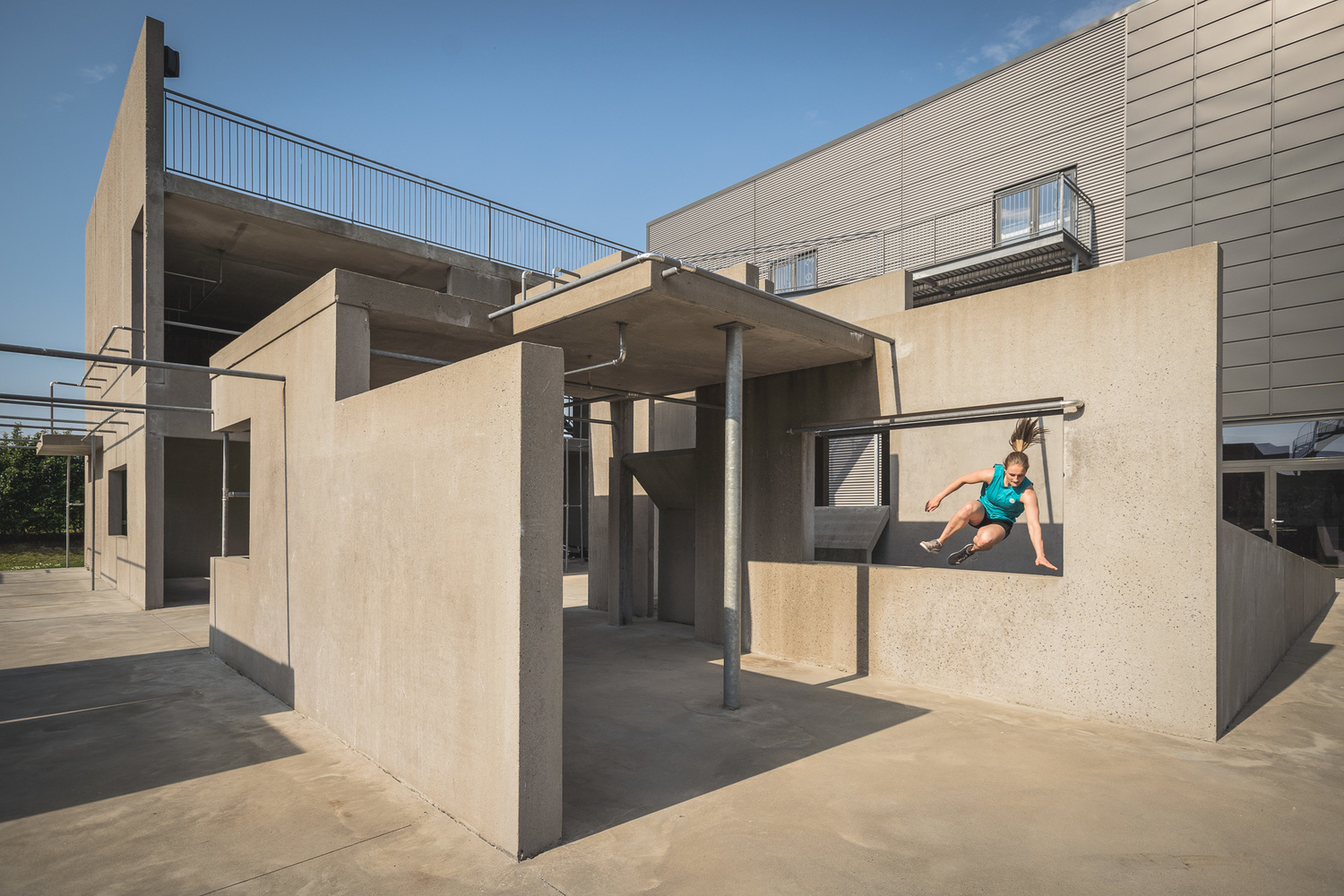I relish a challenge and I knew this job was going to be hard, but I had no idea how much improvisation would be required to complete this shoot and come away with images that worked for the client. Huge venue, one light, complex action, no reccy visit, and just six hours to get it all done.
BGI Akademiet is a school for teenagers, quietly tucked away in the rolling Danish countryside. One of the school’s proudest features is a huge parkour training facility — part-indoor, part-outdoor — almost the size of a football field, and is the largest in the world. Athletes travel from around the world to train there and with good reason: it’s huge, and it’s beautiful.
My client was Copenhagen-based Street Movement, a tiny parkour and architectural company that designed the facility and who were now commissioning me to produce a portfolio of action images to present their work. The difficulty was that my time in Denmark was limited and their budget was tiny. There would be no opportunity to visit the venue; it was simply a case of guessing what we would need, turning up after a 2-hour drive from Copenhagen, and making it work.
As someone who shoots rarely with lights, this was a huge challenge. With the number of obstacles, the tight budget, and incredibly limited time, filling the room with strobes simply wasn’t an option.
In trying to conjure a plan, I took inspiration from this shoot by Patrick Hall and various others by Mike Kelley. I figured that I would attempt something that I’d never tried before: lock off the camera on a tripod, shoot the action using a Profoto B1, and then shoot five to ten images of the huge hall, popping the scene with the B1. I would then composite the images in Photoshop.

The level of challenge was threefold: firstly, I don’t shoot with strobes very often, although that didn’t worry me too much as the Profoto gear is so easy to use. Secondly, I’ve never shot multiple plates before, never mind wandering around trying to do some light painting. Thirdly, my Photoshop skills are limited: I’ve never composited images before but hey, if Patrick and Lee can do it, how hard can it be?
To accompany my Sony a7 III and Canon 16-35mm f/2.8 L (adapted with a Sigma MC-11), I rented the following:
- 2 x Profoto B1
- 1 x Profoto air remote TTL-S
- 2 x light stand
- 1 x Profoto OCF Zoom Reflector
- 1 x Profoto 5’ Softbox Octa
- Spare batteries
- 1 x Barn doors
Because of time constraints and in order to try and keep things simple, I planned only to use one of the B1s but wanted a second in case I needed to improvise. I prefer a soft light whenever possible and my logic was that the smooth fall-off from the massive 5’ Octa would make blending the images in Photoshop that little bit easier.
Upon arriving at the hall, I realized almost immediately that I had been somewhat naive; my plan was not going to work. The hall was simply too vast; wandering around and popping light into the room would take too long, with too many obstacles and so much height that trying to create an even light would be incredibly hard work.
I had to find a different plan. Even though the ambient light in the room was far from bright and at a completely different temperature from the B1s, the choice was clear: I needed to create an action shot captured using the B1 and combine it with a plate (i.e. an empty scene) that used only available light. This would allow me to grab a decent number of images and then battle with the details in post-production — a better option than capturing only two or three shots that were perfect. I knew which my client would prefer.
Keeping the client happy is obviously key to a successful shoot. I had Mikkel Rugaard from Street Movement along for the ride. With most other jobs, this would feel like the client is watching over your shoulder, but Rugaard is a good friend and he was there to assist, as well as help me to talk through my ideas, despite his lack of photographic knowledge. I’d been completely up front with him from the outset: he knew that this was far from ideal shooting circumstances, and I was privileged to feel that he was on my side rather than adding to the pressure.

Dennis and Dora giving me a point on which to focus and trying to estimate where Dennis will be when I pull the shutter, and the client wondering how much more we can get before we need to drive back to Copenhagen.

The result of the piggyback test shot. This is one of two where I accidentally moved the camera in between the action and the plates. I was hoping that I could line it up in Photoshop but ended up having to pretty much cut out the athlete and paste him into the plate. Frustrating.
I was also fortunate to be working with four incredibly skilled and experienced athletes. Photographing parkour is a particularly collaborative process and knowing what to ask of an athlete and when to back off is crucial. In addition, most practitioners are media experts and they know what makes a good photograph, always happy to offer suggestions as to what they can change, or what I can do differently.
I spent twenty minutes wandering around the facility, trying to figure out what to do. The size made it feel a bit overwhelming and it was tricky to figure out the best angles and movements. Instead of relying on solely my own judgment, I asked the athletes to explore (three of them had trained there extensively) and find something that they thought would work. My first set-up was with Emilie Christensen who used to do backflips on horses (seriously) before training in parkour. I deliberately chose the most simple movement possible for my first shot as I knew I might want multiple repetitions. Tiring the athlete with a big movement early on would have been unwise, and any movement at height would have added to the reset time, slowing us down. With a simple vault, Christensen would be back in position almost immediately and she could literally do this move all day without feeling the impact.
In what seemed to set the tone for the day, the first vault that Emilie performed was the best. I did a number of repetitions to cover myself but nothing matched the initial attempt. In the final shot, the posture is not perfect but I was conscious that the goal of the day was to present the entire facility from various angles and featuring an athlete that looked good, rather than have one or two images where the athlete looked spot on. As is often the case, done is better than perfect and I needed to push on with more shots.
Shooting with the Octa brought advantages and disadvantages. Firstly, it kills the amount of light coming out of the B1 meaning that for the action, my ISO was often as high as 1000. If I’d used the zoom reflector or a bare bulb, I would have had a much stronger but more directional light which I feared would make things far more complicated when trying to blend images in Photoshop. In addition, with the large spread of the Octa, I could get the B1 quite close without worrying about light missing the athlete and losing a shot entirely. Had I used the zoom reflector or even a bare bulb, the light would have been a lot further away, giving much harder, even more directional light.
As a rule, I hate using tripods but my method worked quite well. I scouted shots freehand and then set the tripod up to match my position. Rugaard was wielding the Octa, using a mixture of the lightstand or clambering on top of obstacles to get the light in a good position. In retrospect, I probably should have covered myself by hiring the tallest light stand possible, but fortunately it didn’t matter. We were able to get the B1 high enough (typically just a little higher than the athlete) for every set-up.
With the strobe, I chose to shoot at 1/1000th and f/5.6. This aperture gave a compromise between the slightly high ISO and ensuring that as much of the scene was in focus as possible.
Once I’d shot action using the B1 (often with the B1 in the shot), I shot the plates. If I’d done it the other way around, there would have been a risk that we would start shooting the action and want to change something, making the plates useless. I shot a number of exposures to give myself as much flexibility as possible when it came to the edit. I turned off the Profoto trigger, dialed the ISO down to 400, dialed the aperture up to f/9 to try and keep everything sharp from front to back, and did a series of four or five exposures typically between 1/40th and 1/8th of a second.
To complicate matters, not only was I dealing with the different light temperatures of the interior lights (which thankfully did not pulse!) versus the B1, but there was also some bright sunlight creeping in from various windows and doors. I knew that dealing with this in post would be tough, but not impossible.
When I moved from my Canon 6D (original) to the Sony a7 III it was because I wanted a full-frame camera that delivered ten frames per second and without swapping all of my glass. With the 6D, I did not have the luxury of a fast burst rate so I was forced to learn how to time my shots. While this often meant having to ask athletes to repeat movements when I messed up, it also meant that shooting with lights — when a burst simply isn’t possible — is not a daunting prospect.
Once the first shot was in the bag, I could relax a little, knowing that I had a system that worked. It was a challenge not to spend too long trying to plan the angle and action for each shot as it would impact on the total number of images that we could achieve. We had a window of six hours to capture as much as possible, and somehow we also had to squeeze in the huge outdoor section of the facility. Fortunately, the plan for outdoors was to shoot using natural light and it was a bright sunny day. We probably spent two-thirds of our time indoors from which I delivered 8 images, and one third outdoors from which I delivered 25 images.
With four athletes, I was blessed with options but again there are compromises. These are incredibly active people who don’t want to spend hours sitting around waiting to be told what to do. Not only do they need to stay warmed up and ready to go, they also must not get bored as it can affect the mood of the entire group — myself very much included. Energy needs to stay high, but at the same time you don’t want to risk athletes wearing themselves out by training hard while they’re waiting to perform, or risk injuring themselves because their focus is constantly being shifted.
Unfortunately, this is exactly what happened. While doing his own training, one of the athletes slipped when completing a jump and the sharp edge of one of the concrete walls carved a deep gash into his shin. Not too much blood and very little pain, fortunately, but bone was visible and suddenly I was missing both an athlete and an assistant as Rugaard delivered the injured party to the nearest hospital. (He quickly made a full recovery.)
Despite this setback, we pushed on, returning indoors capture more action. Shooting purpose-built parkour training facilities is much harder than photographing parkour taking place in the city, perhaps because of the density and complexity of the structures. Also, my usual trick of lying on the floor and using sweeping lines wasn’t an option, for two reasons: firstly, the architecture simply doesn’t lend itself to that sort of composition. Secondly, for the client, I felt that I needed to shoot with a much more architectural style and keep my verticals as straight as possible. I didn’t mind the collapsing verticals for the outdoor shots as the space felt much more expansive, but for the indoor images, keeping it straight felt essential. In the end, only one of the eight images looked up from a low vantage point.

I kept the verticals as straight as possible for most of the shoot, trying to create an architectural style. Without a tilt/shift lens, this meant shooting at head-height and making some small adjustments in Photoshop once the compositing was complete.
Looking back, there are lots of things that I should have done differently — asking the athletes not to wear black trousers for one, and perhaps spending a bit more time chatting to the athletes about finding potential shots during the times when they weren’t in front of the camera.
Despite that, I’m proud of the results and the client is delighted. If you have any questions or want to offer some thoughts on how you would have approached this shoot, please leave a comment below. For those that are interested, I’ll be adding a second article that discusses my work when compositing the images using Lightroom and Photoshop.
Photographer: Andy Day
Client: Street Movement (Instagram)
Models: Emilie Christensen, Jonas Eduardo Delgado, Dennis Weibel, and Moumen Machlah
Location: BGI Akademiet (Instagram)



















Nice work! Your problem solving skills allowed you to achieve some great composites I think the dim lighting worked in your favor providing a more dramatic shot with the added attention to the well lit athletes.
Just out of curiosity... I see you rented two B1's; however, most of your subjects look like they are lit using one flash source. Was the second just for back-up? Perhaps the second B1 could have been used to back-light your subject?
Thanks Steve!
Yep, I shot with one B1 throughout. Looking back, i think the scale of the shoot and my inexperienced made me feel that attempting anything with two lights would slow things down too much. So yes, the second was just for back up. Adding a backlight would have been a great idea, however. Next time!
Well done, that was a really tough gig, one you'd learn from. If you did it again I'm sure it'd be even better.
One thing perhaps would be some tighter shots on the performers. And some from higher up, which might mean a ladder.
Yep, I agree. The focus of the shoot was to show off the space, but it would have been nice to get a bit closer, both to the athlete and to some of the surfaces to give a feel for the texture. And yes, a ladder would have been useful! Thanks for your thoughts. :)
I think you did a great job. Everything balanced out nicely with good light on your subjects. Did you prefer a particular mm on your lens in that setting?
Thanks Matt. Having a quick glance at Lightroom: 23mm, 16mm, 16mm, 16mm, 35mm, 24mm, 32mm. So I guess not! :)
Great Article and the results are very good, I think you solved in the best way and choose the best option for the situation.
I like ask a few things; first like I read the BW was a little pain during the production and as I see you solved great at post, but there was a kind of adjustment during the shoot, like filters or a specific preset on camera for the WB or grey card?
And my second questions is not directly about the shoot is about the little injury with one of your athletes, how you deal with that kind of situation? Well in this case I understand that is your clients and your models but exist certain friendship between you and I think is more soft solve this events. But what do you thinks is the best way to act in this situation? You must to pay for the hospital, your client or the athlete or prefer carry with a contract or a ensure for this kind of situations?
Well anyway I enjoy read this article and I am great fan of your work from a few years now, I can’t wait for the second part of the article and greetings from México!
Thanks! No, no adjustments or colour profiles during the shoot. I was capturing raw images so I knew that I had a ton of flexibility in post. A grey card would probably have been useful, in retrospect, but I'm not sure it would have sped me up when it came to working in Photoshop. The white balance across one scene was so diverse, i might even have needed to shoot 3 or four grey cards for every set up.
We were lucky that, though the athlete needed to go to hospital, it wasn't too serious. It stopped him from training for a few weeks but there was no damage to muscles, bones, ligaments or tendons, so it was just a case of waiting for the flesh to grow back. The skin on the shin is super thin and while it's never fun to see bone, it's not unusual. In parkour, this type of accident has its own name - a shinjury.
Being Denmark, the national health insurance and high quality of health care meant that the athlete was attended to almost immediately without incurring any personal bills. Furthermore, Street Movement has insurance for its athletes as it is a professional organisation.
When I'm out shooting with friends, it's different: unfortunately for the athlete, the liability is entire with them. This is another reason why I'm so careful to work with people I trust, and there's a good - if informal - understanding of each other's expectations. Perhaps in Europe this all feels a bit easier as we know that accidents don't mean incurring massive healthcare bills. It's all paid for through national insurance.
This is the most serious injury I've experienced on one of my own shoots - hopefully that's testament to the skill, focus and professionality of the athletes that I work with.
I hope that answers your questions. Let me know if you have any others. :)
Thanks!
simply awesome.. great work!
Thanks!